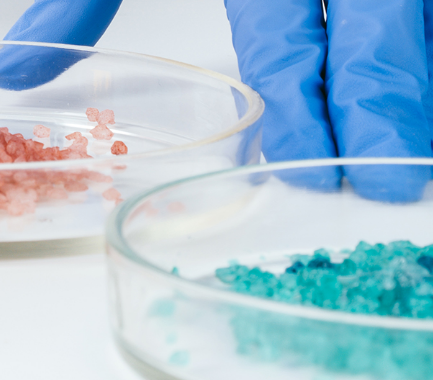Your contact
PENPET-Team - Hamburg

Jan Prager
Sales
Tel. +49 (0) 40 - 675 7 99 10
sales@penpet.de
Get in touch with us.
Triethylene glycol (TEG)
Triethylene glycol (TEG) is an organic compound that belongs to the glycols and is used, among other things, as a humectant and solvent. The substance can be produced by the ethoxylation of the structurally similar diethylene glycol. It is usually obtained as a by-product of the large-scale production of ethylene glycol.
Due to its hygroscopic properties, triethylene glycol is used as a fog liquid, as a humectant for tobacco and printing inks, and for drying and dehumidifying natural gas. As a high-boiling solvent, the compound is also used in processes in the chemical industry that take place at high temperatures. The substance has an antibacterial effect and can be used, for example, to disinfect the air in public buildings such as hospitals. As an additive to hydraulic and brake fluids, triethylene glycol is also important for machine and vehicle construction. The compound is also an important intermediate for the industrial production of other organic compounds, which is used, among other things, for the production of polyester resins.
At PENPET you get triethylene glycol (TEG) of the highest quality - from a reliable partner who will also meet your requirements in the long term. We look forward to receiving your inquiry for an individual offer. Prompt delivery of the liquid compound can be made in packages with different weights.
CAS no. 112-27-6
EINECS no. 203-953-2
Molecular formula: C6H14O4
Synonyms: Triethylene glycol, TEG, triglycol, 2,2′-(ethylenedioxy)diethanol, 2-[2-(2-hydroxyethoxy)ethoxy]ethanol
More Information
Triethylene glycol (TEG) is a double ether whose molecules are each made up of three components of the dihydric alcohol ethylene glycol. The substance consists of three ethyl radicals which are linked by ether groups and have two terminal hydroxy groups. Triethylene glycol (TEG) is therefore also one of the dihydric alcohols and can undergo the typical reactions of this group of substances. Among other things, esterification of the substance with carboxylic acids and the formation of more complex ethers with other alcoholic compounds are possible. Long-chain compounds known as polyethylene glycol (PEG) can be formed by reacting the molecules with one another and by adding ethylene glycol or diethylene glycol.
Triethylene glycol (TEG) is in liquid form under normal conditions. The colorless compound has a very faint, mild odor. The liquid does not boil until it is heated to 291 °C, which also makes it suitable for high-temperature applications. On the other hand, the viscous triethylene glycol solidifies to a solid when it cools below -7 °C. The substance is hygroscopic and attracts moisture. The compound is miscible with water in any proportion. Triethylene glycol is also very soluble in numerous organic solvents such as glycerol, ethanol, acetic acid, benzene, toluene and acetone, but not in oil, fats and many simple hydrocarbons.
Triethylene glycol (TEG) is chemically stable and can be stored safely if stored as intended. However, contact with strong oxidizing agents, strong acids, bases, peroxides and permanganates can result in violent and dangerous reactions.
Liquid triethylene glycol (TEG) is flammable, but is difficult to ignite. However, the vapors of the compound can form highly flammable and explosive vapor-air mixtures with the ambient air. In the gaseous state, triethylene glycol is also heavier than air, so that the vapors can spread unnoticed on the floor of the workroom. As a result, remote detonations of the compound are possible. When handling open containers of the substance, it is therefore important to ensure a sufficient safety distance from possible sources of ignition such as open flames, sparks, strongly heated surfaces and electrostatic charged devices. Toxic and hazardous gases are produced when triethylene glycol is burned. Large amounts of carbon monoxide and carbon dioxide can be released, among other things.
Triethylene glycol (TEG) is not considered a hazardous substance under the GHS classification. If it comes into contact with the skin, at most very slight irritations are to be expected. It is usually sufficient to thoroughly clean wetted parts of the body under running water. In the eye, the compound can cause brief irritation, burning pain and temporary eyelid cramps. Irreversible impairments are unlikely. The affected eye should be carefully rinsed under running water and then examined by an ophthalmologist.
Swallowing the liquid compound and inhaling its vapors and aerosols can cause irritation of the respiratory tract and the mucous membranes of the digestive tract. After the intake and absorption of large amounts of triethylene glycol in the metabolism, disorders of the kidney function and impairments of the central nervous system such as dizziness, headaches, impaired reflexes and unconsciousness can occur. If poisoning is suspected, seek medical treatment.
Triethylene glycol is considered to be slightly hazardous to water due to possible damage to aquatic organisms and should not be released into the environment. The local authorities should be informed of any leakage of large quantities of the compound into soil, waterways or sewage. The substance is not subject to any special transport regulations.
